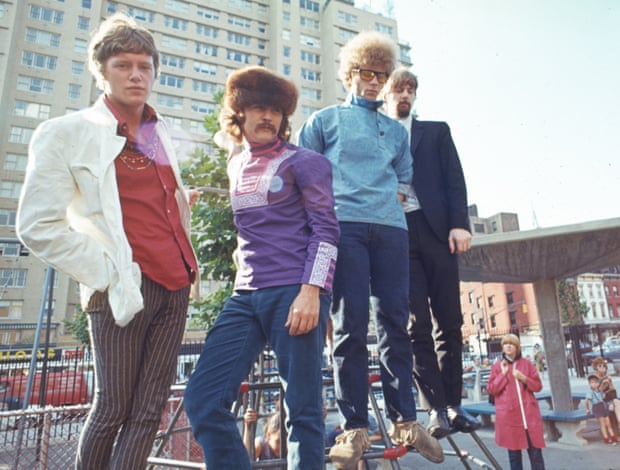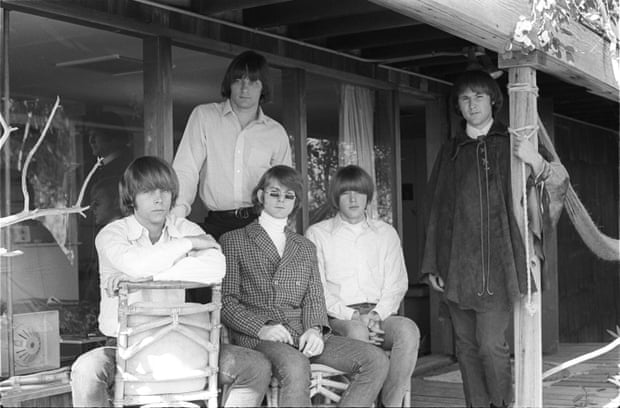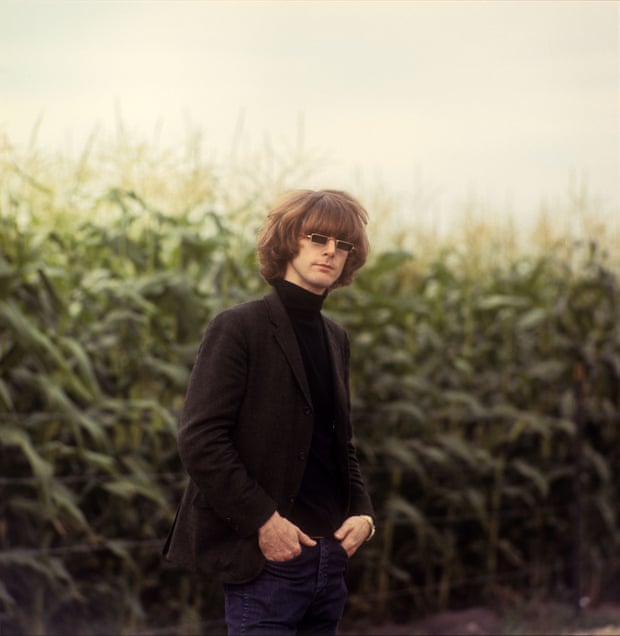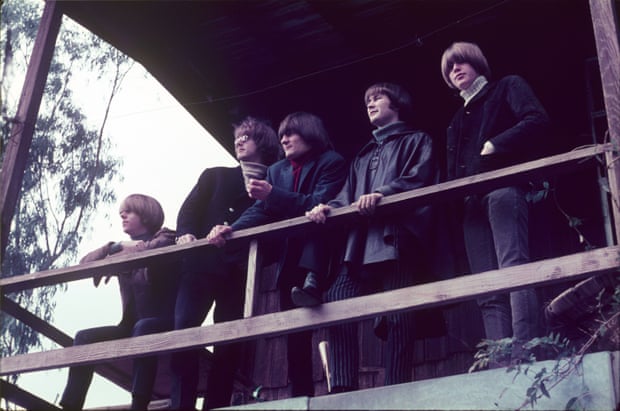Bands choose their members for many reasons, but you’d like to think the ability to play would be towards the top of the list. It didn’t quite work out that way in the summer of 1964 when the Byrds, one of rock’s most influential bands, were finalizing their line-up. With four highly talented members already in place, they lacked only a drummer. Fate struck when they spotted Michael Clarke strolling by the Troubadour club in LA “We didn’t care whether he could play drums or not,” Roger McGuinn recalled the other day with a laugh. “He looked like two of the Rolling Stones rolled into one!”
Specifically, Clarke boasted the dense bangs of Brian Jones and the lush lips of Mick Jagger, not to mention the slim physique of all the classic rockers of the day. The mere fact that one of music’s most consequential and respected bands would prize features like those so highly proves conclusively the power looks, style and fashion hold in popular music. While that may be obvious in the world of contemporary pop, such elements were far more rarely acknowledged in the rock’n’roll world of the 60s, when the mantra was “it’s all about the music, man.”
As McGuinn made clear, however, “when you’re in a band, you want to create a mystique. Visual style has always been very important to that,” he said.
A gorgeous new photo-driven book, titled The Byrds 1964-67, aims to make the case that, during that era, the Byrds had nearly as much resonance in the realm of style as they did in sound. History rightfully records the Byrds as the band that, by dizzying turns, pioneered folk-rock by electrifying Dylan songs like Mr Tambourine Man and Pete Seeger’s Turn! Turn! Turn!, helped create psychedelic and raga rock with songs like Eight Miles High and So You Wanna Be a Rock’n’Roll Star, and set a trend in country rock with the pivotal Sweetheart of the Rodeo album. Through extensive interviews with the three surviving original members – McGuinn, Chris Hillman and David Crosby – the book features many entertaining details about the development of those sounds, as well as the band’s testy interpersonal relationships along the way. But the pictures tell a different story, one fired by a sartorial flair and whimsy, as well as by the power of male beauty. “Tom Petty once said, ‘the Byrds were a good-looking band,’” Hillman recalled with a laugh. “He said, ‘they had great hair and clothes,’ and we did!”

That angle was hardly lost on the teen magazines in the mid-60s which featured them in “groovy” photo spreads underscored by drooling captions. “In those days, before we were constantly bombarded by visual images through social media, it took the presence of a band like the Byrds in the teenybopper magazines and on American TV to present a new gateway for dressing,” said Holly George-Warren, who co-wrote the book Rock in Fashion with designer John Varvatos. “The Byrds were the band that brought the Anglo cool that had been introduced by the Beatles and the Stones to America.”
In fact, when the Byrds chose their initial wardrobe, their template was the early Fab Four. In that vein, they adopted a uniform look, outfitting the members with tab collar shirts and tight black suits trimmed in velvet. But the look didn’t last long and the members never favored it. “We didn’t like the conformity,” Hillman said.
Small wonder they were relieved when their suits were stolen at a club they were playing in one night. According to Hillman, the culprits were members of Little Richard’s band. “When Roger McGuinn told John Lennon about it,” recalled Hillman, “Lennon said, ‘I wish they’d have stolen our suits!’”
In fact, the Beatle suits were the second look adopted by the Byrds. In their formative days, when they were still known as the Jet Set, the initial players wore crisp white shirts that made them look as clean-cut as choir boys. “We had been working with folk bands and they had that look,” McGuinn said. “Groups like the Kingston Trio started that collegiate style and we went with it. Gradually, we became more bohemian.”
“They started to adopt very individual looks,” George-Warren said. “What you saw in that period was an early signpost of what would later become the ‘counter-cultural look.’”

One of the most notable, and imitated, early style choices was McGuinn’s use of tiny, rectangular wire-rimmed glasses, an accessory obtainable for cheap at any drug store. McGuinn made them look distinct by tricking them out with cool blue lenses. He was inspired by the round cobalt blue glasses worn by Lovin’ Spoonful singer John Sebastian who McGuinn had met in his days on the Greenwich Village folk scene. “I said, ‘wow those are cool shades!’” McGuinn recalled. “He said ‘try them on, look up at the street lights and move your head around. It looks really groovy!’ So, I put the blue lenses in. I wasn’t going to wear them all the time but then a TV producer in England saw them and said, ‘everybody needs a gimmick.’”
“A pop star hadn’t had that kind of effect on glasses since Buddy Holly and Roy Orbison,” George-Warren said. “Later, we got to see John Lennon with his granny glasses.”
The book features images of boys in the audience wearing those glasses, initially at Ciro’s, a club on the Sunset Strip where the Byrds first built an audience and a scene. The club, which was outfitted in old Vegas-style booths, had been big in the 1940s when audiences would come for acts like Tony Bennett and Sinatra. By the 60s, it had fallen on hard times. The bookers revived it by booking the Byrds. “We filled that place, man,” said David Crosby. “It was chock full of people and there was a line down the block to get in. Everybody noticed that, which really helped us.”
The Byrds attracted further attention by having their female friends act as go-go-dancers in at Ciro’s, a feature they later brought on the road with them. At the same time, the demeanor of the band members remained cool. “As performers, the Byrds were aloof,” Hillman said. “We weren’t a show band who moved around and smiled.”
To maintain an equally cool look, Hillman faced a considerable challenge. Because he wanted to fit in with the other guys, he worked mightily to straighten his naturally curly hair. “I washed it out and put a setting gel on it,” he said. “I would go through all that work and then then minute we got to the midwest in the summer, where it’s really humid, my hair would ‘boing’ into springs.”

Inspired by the proud curls of Dylan, Hillman eventually let his hair go wild. That dovetailed with the move by various members to adopt more unusual clothes. Their look changed as quickly as their music did. Small wonder McGuinn likened the Byrds to “an electronic magazine” designed to reflect an ever-changing world. Crosby introduced the most eccentric styles in the band, with headwear a focus. In early ’67, he made a statement by refashioning a classic Borsalino fedora. “I saw the Borsalino in the shop and I liked the color,” he said. “I decided to crush the top of it to make it look like a cowboy hat and it really worked.”
Six months later, he sported an ushanka-style hat to match the Russian shirt he had chosen for a photoshoot. In his most theatrical move, he sported a flowing leather cape. “If you want to see something really silly, try riding a motorcycle with a cape on,” Crosby said with a laugh.
“David looked like some kind of hippie superhero riding through the Hollywood Hills,” McGuinn said.
Meanwhile, McGuinn himself favored conservative jackets and ties but flashed up with psychedelic color. “I went to prep school where we had to wear a tie every day,” he said. “So that look was normal to me.”
McGuinn made another statement by sporting a goatee, a look that had been big with beatniks in the 50s but which fell out of fashion by the mid 60s before McGuinn helped revive it. The look came by accident. One day, while riding a razor scooter “I went bam and landed smack on my lip,” McGuinn said. “We had a TV show the next week, so I grew the goatee to hide the bruise.”
The Byrds had a strong visual impact in their album covers as well. Photographer Barry Feinstein used a fisheye lens to shoot the image for their debut in 1965. It was one of the first uses of a technique that later became a psychedelic cliche.

The band member the camera loved most was Gene Clark, a gifted singer who was also the band’s most prolific songwriter in its early days. Clark was Hollywood handsome and, as a picture of the guys in swimsuits makes clear, totally shredded. “He grew up on a Kansas farm, so he was buffed out,” Hillman said. “The guy never went to a gym but he looked like he did. When the curtain would open, every young lady in the house would focus right on him.”
Unfortunately, Clark had mental health issues and also developed a fear of flying which together caused him to quit the band twice. “He just kinda went off the deep end,” McGuinn said. (Clark died of alcohol-related issues at 46, as did Michael Clarke at 47.)
Though the group kept losing members in their early years, they continued to soar musically. Their 1968 album The Notorious Byrd Brothers, which was finalized after the group lost both Crosby and Clark, was a creative triumph that moved them in a more rustic direction both sonically and visually. The musicians’ flair for style lasted beyond the three years covered by the book. When Hillman left the Byrds in 1969 to help form the Flying Burrito Brothers with another ex-Byrd, Gram Parsons, they became the first rockers to sport “Nudie suits”, a style made famous by country stars like Hank Williams and Porter Wagoner. Created by Nudie Cohn, these outfits featured elaborate rhinestones and dense embroidery featuring images of the buyer’s choosing. Parsons’ outfit featured marijuana leaves. Hillman’s boasted giant peacocks.
Hillman’s choice of imagery highlighted one of the most revolutionary aspects of rock style in the 60s. Like peacocks in the aviary world, rock culture focused on males as sex objects rather than females, a shift that was every bit as subversive in the 60s as the music itself. “It was for the gaze of women – and men, though they would never want to admit it,” George-Warren said. “They pretended looks don’t matter. That was always bullshit.”
Beyond the widening of the sexual lens, the era also saw changes in the class of people involved in rock. “Before bands like the Byrds, rock’n’roll musicians had never come from the upper middle class,” said Danny Fields, who edited the teen magazine Datebook in the 60s and who went on to discover Iggy Pop and manage the Ramones. “They were either like Elvis from the south, or working-class Italian kids singing doo-wop in the northeast, or Black. The Byrds were among the first bands that middle-class white kids could really relate to. We worshipped them because they were the first cool American band to make beautiful music and have hits. And they were hot!”
Despite all of the Byrds’ visual allure and musical depth, McGuinn said he found the experience of looking through the book, “a little sad, because the whole thing fell apart in the end.”
But Hillman sees the more positive side. “People who weren’t even alive at the time can now look at these photos and gain a new perspective on the group and how different we were,” he said. “In all manner of things, we were creative.”
Stay connected with us on social media platform for instant update click here to join our Twitter, & Facebook
We are now on Telegram. Click here to join our channel (@TechiUpdate) and stay updated with the latest Technology headlines.
For all the latest Music News Click Here
